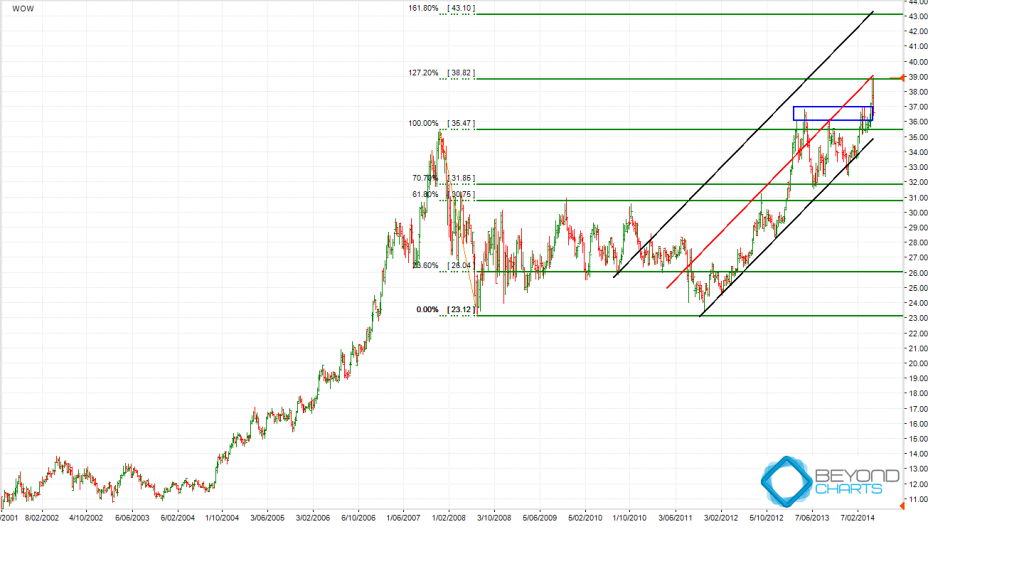An event occurred in the Woolworths (ASX:WOW) share price two weeks ago that has been setting up for nearly 6.5 years, a break out to an all-time new high close.
Woolworths is a household name in Australia and is the 8th largest listed company on the ASX with a market capitalisation of $46.7 billion.
Breakout to an all-time new high
The weekly chart below depicts the Woolies share price back to August 2001. I have taken it back nearly 13 years to try to show perspective on how large market capitalisation stocks’ share prices move.
In the bottom left corner notice that the share price tracked sideways for around three years before a breakout occurred in September 2004 to a then all-time new high. After the consolidation of the breakout a strong up-trend lasted for just over 3 years before reaching a peak at the end of 2007 (middle of the chart).
It took Woolies another 5 years to get above $35.47 and make a new all-time high in March 2013. This is positioned on the chart below at the extreme left of the blue rectangle.
For over a year now Woolworths has battled to break through that initial break out level and in the process has formed an ascending triangle which is a bullish charting pattern. This is depicted on the chart by the blue horizontal rectangle and the lower rising black trend line. Whilst new highs haven’t occurred over the last year, higher and higher lows have occurred caused by buyers moving in earlier and earlier on each short-term pullback and, in turn, indicating increased demand to take positions in Woolworths over the last few months.
More perspective
From a technical analysis viewpoint, large capitalisation stocks require a head of steam to build up to sustained trends but when they get going they tend to keep going for many months and potentially longer.
Prior to 2001 (not shown in the chart above) Woolworths showed similar cycles of prolonged sideways movement of 2 -3 years followed by rising trends of 1 – 2 years.
It is this big picture perspective and stock specific characteristics that an investor should draw on when making bigger picture longer term investment decisions in particular stocks.
Therefore when a significant breakout occurs, such as occurred 2 weeks ago with Woolies, it should be taken seriously.
Where to from here for WOW?
My view is that the breakout above the resistance zone holds more insight into the immediate and longer term direction of the Woolworths share price than the short-term pull back that occurred last week back into the zone marked with the blue rectangle.
A pull back to test the conviction of the breakout is normal price action following a sharp breakout so I am not that concerned about the pullback, provided the share price remains above the lower parts of the resistance zone, which has now become a support zone. This is around the $36 level.
If the share price falls below $36 and remains below it for more than 7 – 10 trading sessions then significant lightening or even closing of a position should be considered, depending on the length of your investment horizon.
However, the odds favour a rising share price within the channel demarcated by the parallel black trend lines and the red median line. A projection to the Fibonacci 161.8% level, which is around the $43 level, is a possibility which coincides with the upper parts of the rising channel of even higher once more time has passed.
Gary Stone is the Founder and Managing Director of Share Wealth Systems.




2 Responses
Good call Gary.
Your last webinar was excellent. Thanks for sharing your views.
youtube.comyoutube.comResponse to Comment by Sim:
Thank you Sim. The recording of the webinar that you refer to is on Youtube:
http://www.youtube.com/watch?v=r_7zmMSrk_s&list=PLSlm6Rw3LUWibMoiTzKStntjVGcLMlwpp
Regards
Gary